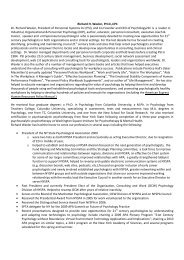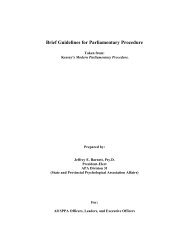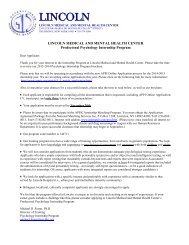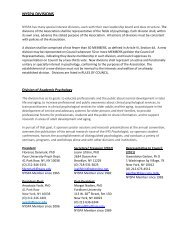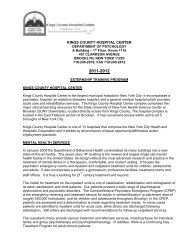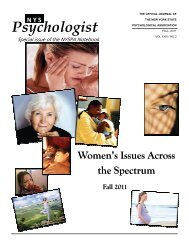NOTEBOOK - New York State Psychological Association
NOTEBOOK - New York State Psychological Association
NOTEBOOK - New York State Psychological Association
Create successful ePaper yourself
Turn your PDF publications into a flip-book with our unique Google optimized e-Paper software.
NYSPA Notebook ~ September 2012<br />
A Fellow’s Reflection on the 2011-12 Leadership Institute Project<br />
Daniel Kaplin, MA, CASAC<br />
NYSPA Member Since 2011<br />
This article focuses on our year as leadership<br />
fellows and well as reflects on<br />
different leadership styles. Leadership<br />
refers to the ability to collaborate with<br />
others towards a common goal (Chermers,<br />
1997; Cohen, Lee, & McIlwraith, 2012). Whenever<br />
a person commits to being in a<br />
position of leadership, it comes with both<br />
opportunity and responsibility (Cohen et<br />
al., 2012).<br />
The 2011-12 Leadership Institute Class<br />
The Leadership Institute is no different in<br />
this respect. As fellows, we were provided<br />
the opportunity to be exposed to<br />
NYSPA council, which is responsible for<br />
determining the direction of our profession<br />
in <strong>New</strong> <strong>York</strong> <strong>State</strong>. Moreover, we<br />
had the opportunity to interact and build<br />
relationships with the current leadership<br />
of NYSPA. This is an invaluable<br />
opportunity for those whom wish to<br />
assume leadership positions in the future.<br />
Fellows of the program, are responsible<br />
for developing a product that would<br />
contribute to NYSPA and the field of<br />
psychology. Each fellow is assigned a<br />
mentor, but are encouraged to be as<br />
autonomous as possible.<br />
Our group decided to create a promotional<br />
video that could be disseminated<br />
to politicians, psychology students, and<br />
the layperson to increase awareness<br />
about psychology (Kaplin, 2012). We<br />
utilized the strength of NYSPA, being its<br />
divisions, regional affiliates, and<br />
members, as a source of funding and<br />
representation. We were fortunate<br />
enough to have the following divisions<br />
represented in the video: Academic,<br />
Addictions, Adult Development and<br />
Aging, Clinical, the Division of Race,<br />
Culture and Ethnicity), Early Career<br />
Psychologists, Forensic, Independent<br />
Practice, Psychoanalysis, Public Sector,<br />
School Psychology, Social Issues and the<br />
Division of Women’s issues. We would<br />
like to thank all of the contributors and<br />
supports of the project.<br />
Video’s will be available<br />
October 1, 2012.<br />
As research suggests, the process of<br />
breaking a large task down into smaller<br />
concrete tasks can help eliminate the<br />
problem of planning fallacy (Koole & Spijker,<br />
2000). Being cognizant of this, our team<br />
set the direction of our project at our first<br />
meeting at the 2011 NYSPA Convention,<br />
developed a fundraising campaign in September<br />
2011, started interviewing in<br />
February 2012, started editing in April<br />
2012, and showcased our promotional<br />
video at the June 2012 NYSPA Convention.<br />
In sum, our success was predicated<br />
on the awareness that we had one year<br />
to complete our goals and there was<br />
minimal room for procrastination. NYSPA<br />
will display these full-length videos and<br />
the integrated promotional video on the<br />
NYSPA YouTube channel.<br />
Leadership Styles in Action<br />
Research suggests that there is a strong<br />
association between parenting and<br />
leadership styles (Ferguson, Hagaman, Grice,<br />
& Peng, 2006). There are four types<br />
parenting styles: authoritative, authoritarian,<br />
permissive and disengaged<br />
(Baumrind, 1996). I would suggest that a<br />
person could determine their leadership<br />
style, albeit imperfectly, by attending to<br />
their parenting style.<br />
Thus, an authoritative parent, who is very<br />
warm and compassionate, but has high<br />
expectations with their children will<br />
demonstrate a democratic leadership<br />
style (Baumrind, 1996; Ferguson et al., 2006).<br />
An authoritarian parent, who has high<br />
demands, but displays little warmth, will<br />
exhibit an autocratic leadership style<br />
(Baumrind, 1996; Ferguson et al., 2006). Lastly,<br />
a permissive parent, who is very warm,<br />
but has low demands on their child, will<br />
exhibit a laissez faire leadership style<br />
(Baumrind, 1996; Ferguson et al., 2006). My<br />
experience is that the disengaged parent<br />
generally does not seek to be in a<br />
position of leadership.<br />
A core component of the Leadership Institute<br />
is to help fellows develop greater<br />
self-awareness of their leadership style to<br />
put them in a position to assume leadership<br />
positions. This is accomplished by<br />
putting many highly ambitious individuals<br />
together to work on a project. Our group<br />
was extremely diverse and we were<br />
faced with experiences that encouraged<br />
us to balance our leadership style with<br />
the leadership style of our peers. I<br />
believe that the Leadership Institute is<br />
successful in accomplishing its goals as<br />
every member my class took advantage<br />
of the opportunities provided and have<br />
assumed positions within NYSPA and its<br />
regional affiliates.<br />
In conclusion, NYSPA invests considerable<br />
resources into the Leadership Institute to<br />
ensure that it is a meaningful experience<br />
for everyone involved. My observation<br />
was that, self-awareness, collaboration<br />
and effective time management are<br />
crucial elements to successful completion<br />
of the Leadership Institute. I would<br />
suggest that the Leadership Institute is a<br />
wonderful opportunity for an emerging<br />
leader to develop self-awareness,<br />
contribute to the field of psychology, and<br />
become more involved in leadership.<br />
References:<br />
Baumrind, D. (1996). The discipline<br />
controversy revisited. Family Relations, 45(4),<br />
405-414.<br />
Chemers M. (1997) An integrative theory of<br />
leadership. Mahwah, NJ: Lawrence Erlbaum<br />
Associates Publishers.<br />
Cohen, K. R., Lee, C. M., & McIlwraith, R.<br />
(2012). The psychology of advocacy and the<br />
advocacy of psychology. Canadian Psychology,<br />
53(3), 151-158. doi:10.1037/a0027823<br />
Ferguson, E., Hagaman, J., Grice, J. W., &<br />
Peng, K. (2006). From leadership to<br />
parenthood: The applicability of leadership<br />
styles to parenting styles. Group Dynamics:<br />
Theory, Research, and Practice, 10(1), 43-56.<br />
doi:10.1037/1089-2699.10.1.43<br />
Kaplin, D. (2012, May). The adventures of<br />
being a Leadership Fellow from an experiential<br />
perspective. Clinical Perspectives, 12, 3-4.<br />
Koole, S., & Spijker, M. (2000). Overcoming<br />
the planning fallacy through willpower: Effects<br />
of implementation intentions on actual and<br />
predicted task-completion times. European<br />
Journal of Social Psychology, 30(6), 873-<br />
888. 15



